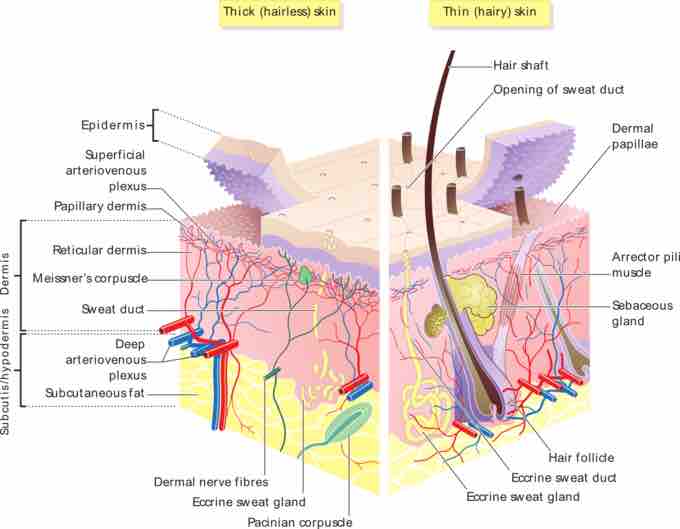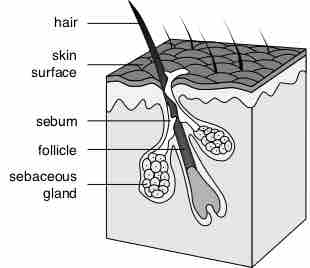Hair
Hair is present on almost the entire surface of our body, excluding certain regions such as the palms of our hands, soles of our feet, and some genital areas. In certain places, hair is so small that it is virtually invisible to the naked eye and in other places it is quite obvious, like on our head and in our armpits.
Structure
A hair can be divided into two main parts lengthwise:
- The root is part of the hair enclosed by the hair follicle, which is itself a tube-like involution of the skin.
- The shaft is the part of the hair projecting from the surface of our skin. A round shaft results in straight and coarse hair. An oval hair shaft is responsible for wavy hair. A flat shaft causes curly hair.
Each hair can also be broken into three main parts. They are, from the most superficial to the deepest:
- Cuticle, the outermost portion. This layer is composed of scale-like cells that seem to overlap in a shingle-like manner. Such an arrangement helps prevent hair from matting.
- Cortex, the middle portion. This portion is made up of layers of elongated and flattened cells.
- Medulla, the inner (central) portion. This is made up of large cells with many sides and air spaces.
There are three types of hairs:
- Lanugo, found on the fetus and for a bit after birth.
- Vellus, fine body hair (peach-fuzz hair).
- Terminal hair, the coarse hair.
Growth and Composition
In the deepest portion of the each hair follicle lies the hair bulb. It is supplied with nutrients via blood by a structure called the hair papilla. The hair bulb has a growth zone called the matrix. Here, stratum basale epithelial cells divide via mitosis to form the hair.
As new cells form, they push older cells up to the surface. These older cells die and become keratinized in the process. This means that most hair is made up of protein (keratin).
The hair bulb also contains cells called melanocytes that produce various kinds of melanin pigments. Their varying combinations are what help to produce the different natural hair colors people have.
Hair grows in three stages:
- Anagen phase, the fast growing phase.
- Catagen phase, the involution phase.
- Telogen phase, the rest phase.
Purpose
Depending on the kind of hair and location, hair can have one of several purposes:
- Expression. Hair on our eyebrows may have stuck around on our body to help gauge a person’s emotions or intent.
- Protection. Eyelashes help protect our eyes and nose hairs keep things out of our respiratory system. Hair on the head helps add a small cushion against bumps.
- Sensation. Hair helps us sense light touches.
- Warmth and defense. Attached to a hair follicle is a bundle of muscle fibers. They help comprise the arrector pili muscle that causes the hairs on our body to stand on their ends when we’re cold or we’re scared. The standing of the hair on end also dimples the skin and thus produces goosebumps. In non-human mammals this action may help add an insulating layer of air between the hair (called fur in non-human mammals) and skin, or it may be used as a way to make a scared animal look larger to its enemy. Neither function is all that relevant or useful in humans, although some warmth is provided by scalp hair.

Skin overview
Skin layers, of both hairy and hairless skin.

Hair follicle
Cross section of a hair follicle.